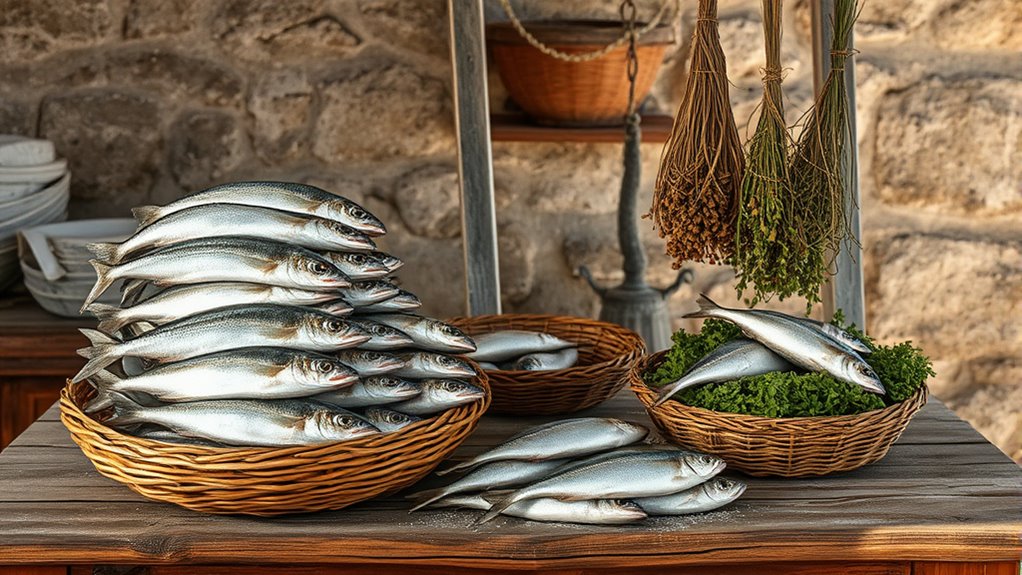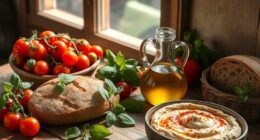Traditional preservation methods like salt, air, and time have been used for centuries to keep food safe and flavorful. You use salt to draw moisture out or create an inhospitable environment for bacteria. Air helps in drying foods, while time allows natural processes like fermentation to develop. These simple techniques require minimal equipment and rely on natural elements. If you want to discover more about how these methods work, there’s much more to explore beyond this quick overview.
Key Takeaways
- Salt acts as a preservative by drawing out moisture and creating an inhospitable environment for microbes.
- Air drying removes water content, preventing microbial growth and spoilage in foods like herbs and meats.
- Time allows natural fermentation and drying processes to develop flavor and ensure safety of preserved foods.
- Combined use of salt, air, and time enhances preservation, flavor, and nutritional retention in traditional methods.
- These methods rely on minimal equipment, utilizing natural elements and patience to extend food shelf life.

Have you ever wondered how people kept food fresh before modern refrigeration? Long before refrigerators and freezers, communities relied on traditional preservation methods that harnessed natural processes to extend the shelf life of perishable items. Two of the most effective techniques were fermentation and drying, both of which use simple yet powerful principles rooted in nature. These methods not only preserved food but also enhanced flavors and nutritional value, making them essential in historical diets.
Fermentation techniques stand out as some of the most fascinating preservation strategies. By encouraging beneficial microbes to grow on food, fermentation transforms and preserves it simultaneously. When you ferment vegetables like cabbage into sauerkraut or cucumbers into pickles, bacteria such as lactic acid bacteria break down sugars, producing acids that inhibit spoilage organisms. This process creates an acidic environment that keeps the food safe to eat for extended periods. Fermentation also develops complex flavors and boosts nutritional content, making preserved foods more appealing and healthful. Historically, cultures worldwide perfected their fermentation methods, passing down secrets that turned simple ingredients into long-lasting staples. These techniques required minimal equipment—just salt, water, and patience—yet the results were remarkably effective.
Fermentation transforms and preserves food, enhancing flavor and nutrition with minimal equipment.
Drying methods are another ancient way to preserve food by removing moisture, which bacteria, molds, and yeasts need to grow. You might be familiar with drying herbs, meats, or fruits, and these practices are among the oldest preservation techniques. By exposing food to sun, wind, or low heat, you reduce its water content, drastically slowing down microbial activity. This method not only prevents spoilage but also concentrates flavors and sugars, giving dried foods a unique taste profile. Different drying techniques evolved based on climate and available resources; for example, sun drying is common in hot, dry regions, while air drying in shaded areas is preferred elsewhere. Drying is simple, effective, and requires no special machinery—just natural elements and time. Many traditional cultures relied on drying to store foods through harsh seasons, ensuring a supply of nourishment long after harvest. Additionally, the development of modern preservation techniques, such as canning, built upon these ancient methods to further extend food storage capabilities.
Both fermentation and drying methods exemplify human ingenuity in making the most of natural processes. They are sustainable, require little investment, and produce foods with distinct flavors and textures. These techniques highlight the importance of patience, observation, and understanding of nature’s cycles. By mastering fermentation techniques and drying methods, you tap into a rich culinary heritage that relies on simple yet powerful principles. They remind you that preservation isn’t just about extending shelf life; it’s about connecting with traditions that honor the natural qualities of food, ensuring nourishment and cultural continuity across generations.
Frequently Asked Questions
How Do Salt, Air, and Time Compare to Modern Preservation Techniques?
You might wonder how salt, air, and time compare to modern preservation techniques. Traditional methods rely on fermentation processes, where microbial activity slows spoilage naturally. Modern techniques often use refrigeration, chemical preservatives, or packaging to control microbial activity more precisely. While traditional methods harness natural processes, modern approaches offer faster, more consistent results. Both aim to preserve freshness, but technological advances give you greater control over microbial activity and shelf life.
Are Traditional Methods Suitable for All Types of Food and Materials?
You might wonder if traditional methods suit all food types and materials. While salt, air, and time work well for some, they aren’t universally compatible. For instance, high-moisture foods may spoil despite these methods, and delicate materials can degrade or warp. You need to take into account food type compatibility and material-specific limitations before relying solely on these ancient techniques. Recognizing their constraints helps you choose the best preservation approach for each item.
What Are the Environmental Impacts of These Preservation Methods?
You might wonder about the environmental footprint of preservation methods. Salt, air, and time are generally sustainable, but their impacts vary. Salt production can cause habitat damage, while air drying consumes energy and space. Sustainability considerations include resource use and waste. Overall, these methods tend to have lower environmental impacts than modern alternatives, but mindful application guarantees they remain eco-friendly options.
How Do Cultural Practices Influence Traditional Preservation Methods?
Cultural practices shape how you preserve food, turning preservation into more than just a method—it’s a dance of tradition and identity. Ritual practices often dictate specific techniques, like salting or drying, which carry deep cultural significance. These methods become a living demonstration to your community’s history, values, and beliefs, making preservation a sacred act that bonds generations and preserves not just food, but cultural heritage itself.
Can Traditional Preservation Methods Be Combined With Modern Technologies?
You can definitely combine traditional preservation methods with modern technologies through innovative integration. By blending age-old techniques like salting or air drying with advanced methods such as refrigeration, vacuum packaging, or digital monitoring, you enhance preservation innovation. This approach not only preserves cultural practices but also improves efficiency and safety, ensuring food or artifacts stay protected longer. Embracing this synergy allows you to honor tradition while leveraging modern advancements effectively.
Conclusion
By embracing salt, air, and time, you tap into nature’s own time-tested vault of preservation. These methods act like silent guardians, patiently waiting to preserve your bounty and stories for generations. When you harness their power, you’re not just extending freshness—you’re weaving a thread through history, turning simple ingredients into timeless treasures. Remember, in the dance of preservation, these ancient techniques are your steady, unwavering partners guiding you through the ages.









